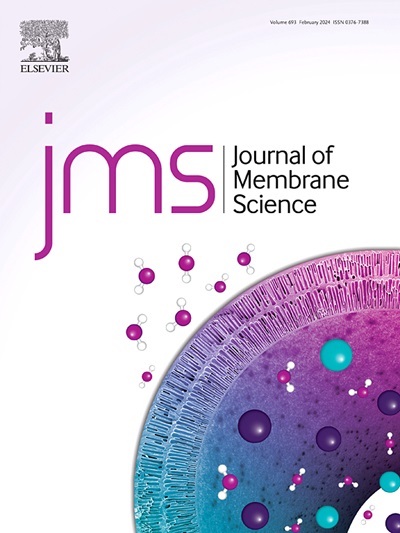Manipulating the ionization of polyamide nanofiltration membrane for cascade separation of low-molecular-weight tobacco extracts
IF 8.4
1区 工程技术
Q1 ENGINEERING, CHEMICAL
引用次数: 0
Abstract
Nanofiltration (NF) is a promising technology capable of separating various organic molecules from mixtures. However, the application of current NF membranes for tobacco extracts with similar molecular weights (MWs) suffers from the limited separation capability due to their intrinsically wide pore size distribution, especially the inability to reject molecules with low MWs. Here, we present an electrostatic interaction regulation strategy for molecules and membranes by controlling the ionization behavior of both polyamide membranes and compound molecules to selectively separate low MW tobacco extracts with similar sizes. It was achieved by meticulously tuning the membrane chargeability and solution pH to dissociate or protonate charged groups of the membrane surface and targeted molecules. As a result, compared with the original solution, the rejection of low MW tobacco extracts—phthalic acid, benzoic acid, and ethyl vanillin—increased by 98.4, 83.0, and 82.4 %, respectively, after adjusting the feed solution pH. Furthermore, by manipulating ionization behavior, the membrane effectively rejected similarly charged molecules while allowing neutral and oppositely charged molecules to pass, successfully facilitating the separation of electronegative, electropositive and electroneutral mixtures. In the four-stage membrane cascade system, all tobacco extracts in the mixture were stepwise separated and purified, increasing the purity of each molecule (phthalic acid, benzoic acid, ethyl vanillin, nicotine, and 2-phenylethanol) from 20 % to over 70 %. Overall, this study developed a novel membrane cascade system by manipulating the molecular-membrane electrostatic interactions, providing an efficient and energy-saving method for the separation and purification of small-molecule tobacco extracts with similar MWs.

操纵聚酰胺纳滤膜的电离用于低分子烟草提取物的级联分离
纳滤技术是一种很有前途的技术,能够从混合物中分离出各种有机分子。然而,目前的纳滤膜在类似分子量的烟草提取物中的应用,由于其固有的宽孔径分布,分离能力有限,特别是不能排斥低分子量的分子。本文提出了一种分子和膜的静电相互作用调节策略,通过控制聚酰胺膜和化合物分子的电离行为来选择性地分离具有相似大小的低MW烟草提取物。这是通过精心调整膜的可带电性和溶液pH来解离或质子化膜表面和目标分子的带电基团来实现的。结果表明,调节进料溶液ph后,低分子量烟草提取物邻苯二甲酸、苯甲酸和乙基香兰素的去除率分别比原溶液提高了98.4%、83.0和82.4%。此外,通过控制电离行为,膜有效地拒绝了类似电荷的分子,同时允许中性和相反电荷的分子通过,成功地促进了电负性分子的分离。正电和电中性混合物。在四级膜级联系统中,混合物中的所有烟草提取物被逐步分离和纯化,使每个分子(邻苯二甲酸、苯甲酸、乙基香兰素、尼古丁和2-苯乙醇)的纯度从20%提高到70%以上。综上所述,本研究通过控制分子-膜静电相互作用建立了一种新型的膜级联系统,为具有相似分子量的小分子烟草提取物的分离纯化提供了一种高效节能的方法。
本文章由计算机程序翻译,如有差异,请以英文原文为准。
求助全文
约1分钟内获得全文
求助全文
来源期刊

Journal of Membrane Science
工程技术-高分子科学
CiteScore
17.10
自引率
17.90%
发文量
1031
审稿时长
2.5 months
期刊介绍:
The Journal of Membrane Science is a publication that focuses on membrane systems and is aimed at academic and industrial chemists, chemical engineers, materials scientists, and membranologists. It publishes original research and reviews on various aspects of membrane transport, membrane formation/structure, fouling, module/process design, and processes/applications. The journal primarily focuses on the structure, function, and performance of non-biological membranes but also includes papers that relate to biological membranes. The Journal of Membrane Science publishes Full Text Papers, State-of-the-Art Reviews, Letters to the Editor, and Perspectives.
 求助内容:
求助内容: 应助结果提醒方式:
应助结果提醒方式:


